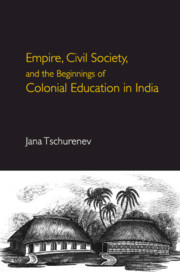Book contents
- Frontmatter
- Dedication
- Contents
- List of Figures
- List of Tables
- List of Abbreviations
- Acknowledgements
- Introduction: Empire Civil Society, and Educational Transformation in India
- 1 A Colonial Experiment in Education, Madras, 1789–1796
- 2 Education of the Poor, 1805–1813
- 3 Missionaries, Empire, and the Cause of Universal Education, 1792–1824
- 4 Race, Class, and Gender: The Social Agenda of Education, 1809–1830
- 5 Rules and Numbers: Transforming Rural Education, 1814–1830
- 6 Intellectual Conquest: Education Societies, ‘Useful Knowledge’, and the Bengal Renaissance, 1817–1854
- 7 Civil Society, Government, and Educational Institution-Building, Bombay Presidency, 1819–1882
- 8 Teaching the Marginalized: Universal Education and the Politics of Inequality, 1789–1937
- Conclusion: The Emergence of Public Elementary Schooling in an Imperial Frame
- Bibliography
- Index
7 - Civil Society, Government, and Educational Institution-Building, Bombay Presidency, 1819–1882
Published online by Cambridge University Press: 26 April 2019
- Frontmatter
- Dedication
- Contents
- List of Figures
- List of Tables
- List of Abbreviations
- Acknowledgements
- Introduction: Empire Civil Society, and Educational Transformation in India
- 1 A Colonial Experiment in Education, Madras, 1789–1796
- 2 Education of the Poor, 1805–1813
- 3 Missionaries, Empire, and the Cause of Universal Education, 1792–1824
- 4 Race, Class, and Gender: The Social Agenda of Education, 1809–1830
- 5 Rules and Numbers: Transforming Rural Education, 1814–1830
- 6 Intellectual Conquest: Education Societies, ‘Useful Knowledge’, and the Bengal Renaissance, 1817–1854
- 7 Civil Society, Government, and Educational Institution-Building, Bombay Presidency, 1819–1882
- 8 Teaching the Marginalized: Universal Education and the Politics of Inequality, 1789–1937
- Conclusion: The Emergence of Public Elementary Schooling in an Imperial Frame
- Bibliography
- Index
Summary
If it be admitted that the assistance of Government is necessary, the next question is, how it can best be afforded, and there are two ways which present themselves for consideration. The Government may take the education of the natives entirely on itself, or it may increase the means and stimulate the exertions of the society already formed for that purpose. The best result will probably be produced by a combination of these two modes of proceeding. Many of the measures necessary for the diffusion of education must depend on the spontaneous zeal of individuals […]. The promotion of those measures, therefore, should be committed to the society; but there are others which require an organized system, and a greater degree of regularity and permanence than can be expected from any plan, the success of which is to depend upon personal character. This last branch, therefore, must be undertaken by the Government.
The history of the monitorial movement in Bengal has shown that setting up a public educational infrastructure was impossible without substantial and reliable governmental investment. Most of the elementary schools that were defunded in the wake of the Anglicist policy turn had to close. Schools such as the Benevolent Institution for the Instruction of Indigent Christians and organizations such as the Calcutta School Book Society (CSBS), which received government grants, however, survived for decades. The monitorial movement became entangled in several ways with the development of the colonial educational policy. Most of the original members of the General Committee of Public Instruction (GCPI) in Bengal (1824) had been running the CSBS before; and after 1854, when the government started its efforts towards educational system-building, it incorporated the CSBS's textbook production and dissemination in its institutional set-up.
This chapter shifts the focus to the Bombay Presidency to explore the monitorial movement's impact on educational system-building. It analyses the shifting modes of educational governance and the constant renegotiation of the colonial government's responsibility to provide schools for the Indian population. What was the state's role in ‘the diffusion of education’, as the afore-cited minute by the Governor of Bombay, Mountstuart Elphinstone (1779–1859), put it? What was better left to the ‘spontaneous zeal of individuals’ and voluntary associations? How to deal with missionary initiative?
- Type
- Chapter
- Information
- Publisher: Cambridge University PressPrint publication year: 2019



